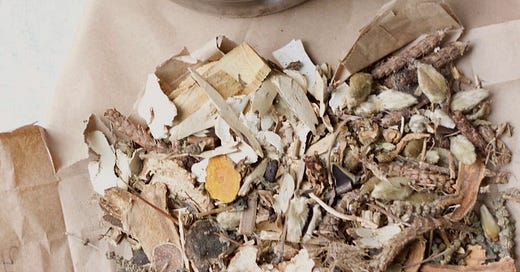Beginner’s Guide to Chinese Medicine Modalities: Part One
Herbs, Acupuncture & Moxa
Most people think acupuncture is all about needles. When I went to my first acupuncturist, although I had an idea about nutrition and herbs, I figured it was mostly needles too. I soon found out there were other things involved — to my surprise, when a glass cup was suctioned to my backside with a flame! Even when I began my studies several years later, I didn’t know how important the other aspects of Chinese Medicine were, and just how much I would love the herbs, wellness practices, and adjunct therapies.
While some acupuncturists do focus on needles, others prioritize other parts of Chinese Medicine or spread their work more evenly. Most Classical Chinese Acupuncturists are trained in all of these modalities, except Chinese herbs, which can take an extra year or two of study. In this 3 part series I will explain the modalities of Chinese Medicine and shine some light on the mysterious tools and techniques hiding out in Acupuncture offices around the world.
1. Herbs, Acupuncture, Moxa — Most Invasive, But Deeply Acting and Potent
Herbal Medicine 草藥
Herbal medicine is used in the West and many cultures around the world; however, Chinese herbs are different in a few ways:
The herbs are traditionally Chinese and aren’t always available in other countries. Some Chinese herbs are only found in China or East Asia and need to be shipped, while some people prefer to use only local herbs, it is wonderful to have access to medicines from afar with such well documented history.
The methodology is different. Instead of using single herbs such as dandelion root, they are mainly prescribed in complex formulations called herbal formulas, with very specific reasons for each ingredient. They are cocktails of herbs which are prescribed for the diagnosed pattern of the patient, and not individual symptoms. The herbs are understood in terms of their energetic properties relating to the pattern and not in terms of the actions and constituents. For example: cinnamon bark has the action “warms and tonifies yang” whereas, in Western herbalism, it is “anti-bacterial, anti-inflammatory, analgesic” etc. Each herb affects specific organs and channels, moves in a direction (up, down, inwards, outwards), has a flavour, temperature, and action — which are all taken into account when studying and prescribing herbs.
The herbs aren’t all herbs. What I mean is that the herbs aren’t all botanical (such as petals, leaves, stems, roots and bark), fungi (mushrooms) or algae, as in the Western view of herbal remedies. Chinese herbs may also be minerals, animal parts, prepared foodstuffs (such as dried tangerine peel or fermented soybean) and even animal feces (Wu-Ling-Zhi among others)! I hope I haven’t scared you away with that one. Because Chinese Herbs are some of the most powerful medicines on the planet and have no side effects if prescribed and taken correctly (only side benefits, like removing bloating when you came in for a skin condition) careful prescription is necessary. If taken incorrectly, they can cause harm. Raw herbs were traditionally boiled into often bitter-tasting teas, but can also be taken in pill, or powder form — called granules.
Acupuncture 針灸
We mostly know acupuncture as little needles, but the Chinese character for acupuncture actually translates to “needle and moxabustion” — which is the burning of the herb mugwort on or near the skin.
The acupuncture half of the equation means the insertion of fine needles into the skin, subcutaneous layer, or as deep as the muscle fibres. Acupuncture styles and treatments vary widely, while typically several needles are inserted and the patient is left to relax for 20-40 minutes, the length of treatment, number of needles, and style of needling depends upon the patient’s needs and the practitioner’s style. In fact there is a great diversity in acupuncture styles, ranging from Classical Acupuncture and TCM to Five Element acupuncture, Japanese, Korean, and Mongolian acupuncture, and specific lineages and teachers, including Dr Tan’s Balance Method, Master Tung’s Acupuncture, and Applied Channel Theory, to name a few popular methods.
You may have heard of “dry-needling” or “IMS” (intramuscular stimulation) which are physiotherapy terms for acupuncture. While generally fewer needles are used, mostly used for the treatment of pain, with an in-and-out method; it is a misunderstanding that it is not acupuncture. The concepts were taken from Chinese medicine and they use the same sort of needles with overlapping techniques and point locations. In fact, there are various needling techniques within the scope of acupuncture, such as trigger point, electrical stimulation (E-Stim), plum blossom needling, and even blood-letting. While most practitioners take a cautious, gentle approach and have the reputation of being more gentle than physiotherapists and MDs, others may delve into more stimulating or intense approaches depending on the patient.
Moxabustion 灸
Moxabustion or “moxa” is the burning of the herb mugwort on or near the skin. This is used to stimulate the acupuncture points in a different sort of way. It works on the heat receptors of the skin and the warmth emitted is infrared, which can penetrate deeply into the body. The most common use of moxa is to warm “Yang Qi”, “Tonify Qi and blood,” and “dispel Cold” — or, more simply, moxa warms up cold bodies, nourishes, strengthens, and relieves certain types of aches and pains.
Thank you for reading Part One to my Guide to Chinese Medicine Modalities, I hope you gained some understanding or inspiration to go visit your local acupuncturist with eager curiosity!
Please join the conversation below, and like & share this article with someone who would enjoy it.
— Morven



